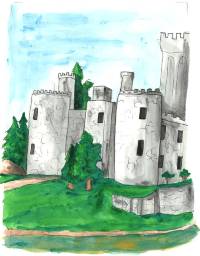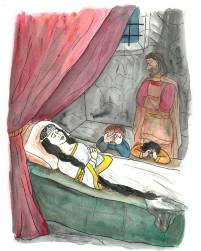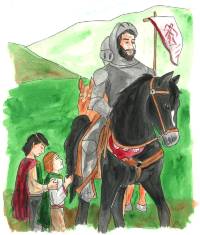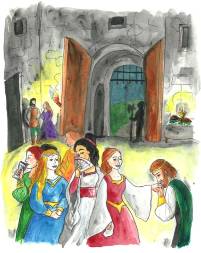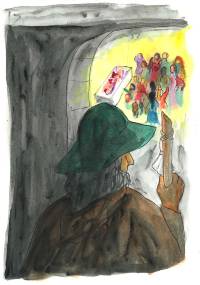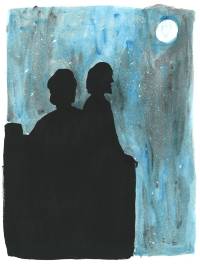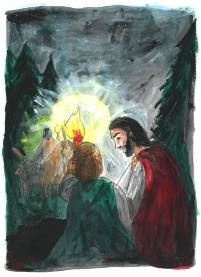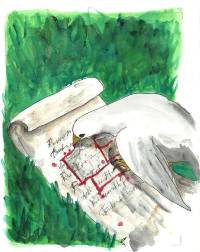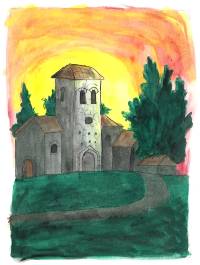The narration of Notre Dame de Colombier
The Aude is the land of legends! Monsignor Rivière discovered this legend in 1930 and wove a poetic and edifying narrative from it. A plaque is attached beside the door of the chapel. Even though legends are considered fictitious, they nonetheless bear the scent and exhale the charm of the country from which they arise. Ms Martine Lauri recorded this Easter story in 1965. This is what he (Rivière) says:
Long ago in the dark Middle Ages, raised on the keep where stands the current village, the banner bearing the colours of the Counts of Montbrun fluttered in the breeze. The fortified castle, considered one of the most important places in all the land, was a refuge for all those who asked a haven: knights returning from the Crusades or pilgrims who had gone astray. With great pomp and circumstance both Church dignitaries and secular authorities were received, including –in his time—Simon de Montfort, Earl of Leicester, notorious in the Occitan country. The castle attracted others too: jugglers, lute players, and minstrels.
However, this day a wind of sorrow blew round the fortress.
The maids spoke softly and motioned silently in gestures. The baker ceased his kneading. A mourning veil lay over the beehives. The bronze bells in the bell tower took up a doleful tolling, with very slow strokes. The great white whippets had leapt from the hearth and were running along the palisades (wooden fences that surrounded fortified castles), snuffling the ground, stopping to cry, thrusting their noses in the air.
In the huge room, resting between the curtains of a large bed painted with the noble coat-of-arms, lay the Lady of Montbrun in death. Her black hair, crowned in a netting of pearls and plaited in long braids, ran the length of the brocade of her robe. Next to her, heartbroken, Lord Robert de Montbrun, her husband, suffered his grief in silence. Two orphaned sons wept next to him. On that night, in the glow of torches, they laid the Countess to rest with her ancestors in an illustrious tomb.
The months passed...three times the wheat was mown. Three times the wine flowed from the winepresses and filled the barrels. Still the grief throbbed just as vividly in the heart of Count Robert.
One day, he announced to his sons and relatives his intention to go to war to Palestine. The Holy King Louis IX was leading a Crusade. And so, the Count of Montbrun left to join him in the Land of Aigues-Mortes, to embark with him on one of his vessels.
For a long time they waited for news of him. Every day, his young sons climbed on the tower to penetrate the secret of the horizons. One day, they believed they saw him, sitting atop his black steed, armed in his chain mail, the feathers of his helmet whipping in the wind. Alas, it was only an illusion...at most, a wandering knight looking for respite. After a while, the silence became habitual. They learned of the Crusaders’ defeat at Mansourah and the imprisonment of the King. The young earls lost all hope for the return of their father.
Since they had come of age to take wives and begin families of their own, the young earls invited to the castle eligible young women of the surrounding countryside. They had become passionate hunters, training falcons and building up a magnificent pack of hunting dogs: the fastest, the best trained... and the cruellest.
The lilacs danced in colourful clusters on their branches. The gillyflowers flourished in the loopholes. The sun shone warmly round the pond as the guests gathered and chatted in the castle’s forecourt. All looked forward to the evening’s light comedy performance. Troubadours (northern French poet and singer during the Middle Ages) and minstrels (musicians from the European Middle Ages) had been entertaining the guests in the square since the morning. It was in vain that the village priest had condemned these worldly festivities during Holy Week. For this day was the eve of the Solemnity of the Resurrection.
Soon it would be evening, and then night. In the large portico, the glowing wax of the torches crackled. The reflections of the shadows seemed to move the vaults. Knights and ladies mingled in festive costumes, gold and silver sparkling with their every movement. The troubadours competed with one another to be the wittiest, singing of the lords and counts and the enchantment of the guests, who were sitting at the great table of the banquet.
Suddenly at the door was heard a hard knocking, which reverberated through the galleries. It was a poor pilgrim who longed to talk with the Lords of the House. In all their festive joy, they gave no answer. The unwanted visitor was removed. The meal was very good, generously served. The cutting squires cut the fine meat into large pieces. The cup-servants poured the Grenache, which shone like the crimson colour of dawn. Again, the knocker made the nail-battered sally port moan. When the chamberlains approached the Lord Masters to remind them again of the desire of the unknown pilgrim, they started up, red-faced with anger: “Away, that nuisance!” cried the younger. “Let loose the pack!” screamed the elder. Imperiously, they raised their cups and the jugglers began again with their magic tricks and their songs.
When the guests had withdrawn for the night, the two brothers climbed atop the tower, as was their wont. The exquisite wine and the beauty of the young ladies kept their minds in a kind of blissful intoxication. The full moon lit the oak grove below, where the swineherd every autumn harvested acorns for his animals. The cers (local West Wind in the Languedoc) was blowing very gently. Hidden in the trees, tawny owls emitted regular, mournful cries.
Suddenly the howling of angry dogs arose, followed by a human clamour, sounding as battle cries. Very pale and soberly, the young men looked at each other. “The unknown pilgrim!” they gasped.
As they rushed down the spiral staircase, they alerted their huntsmen and threw themselves into their saddles, galloping to the small valley from whence the cries arose. The spectacle that awaited them was nothing short of horrific. Sides torn, limbs broken, throat ripped open, lay the body of the pilgrim in its blood. The huntsmen struck the dogs to tear them loose from their prey. The scent of blood had aroused the wolvish instincts of the dogs. It was thus with great difficulty that the animals were gathered as the two young men approached.
The man had died. On the sword-belt under his woollen robe hung a velvet purse with a parchment. The two earls Montbrun inspected it, were overwhelmed, and fell to their knees. Supporting each other, shattered by despair, they recognized their father. Under the clotted blood of his finger, they recognized the ring of the Count, etched with their coat of arms.
“A curse rests upon us,” they said. “We have profaned the Holy Easter Vigil.” And from their eyes fell tears of true contrition. They looked at the stained facial features of their father. They recognized in the face their own features. They realized their mistake, their misery, and were utterly crushed. “Alas!” they said. “Could but this offended heart send us a sign of forgiveness to bring peace to our deeply troubled souls!”
Almost immediately, the rays of dawn crept over the sky and a flock of doves, arising from some unknown place, began to flutter about them. Repeatedly the doves circled round their heads, then one alighted on the shoulder of the victim. In the pool of blood in the open heart, she dipped her beak and on the unrolled parchment, on which the count had written the feats of the Crusade, she sketched, just as it should be built, the outline of a chapel.
All present cried over the miracle, bowing their heads at length. The lone dove joined the others and all disappeared in the same way as they had come.
Fully convinced of the presence of the hand of God—and to expiate the guilt of their sin—the young men pledged to have built in stone, according to the pattern given to them by such a miraculous sign, a cruciform church, that is, composed of nave and transepts. This should be named Notre Dame de Colombier, in honour of Our Lady and in remembrance of the doves that appeared about the body of their deceased father. They faithfully fulfilled their promise and to this day stands the honourable and venerated building we have here before us.
Then the sun rose above the mountains and everything was illumined by her rays of gold. This became the sign of forgiveness. It was the day of new beginnings. It was Easter Day.
Notre Dame de Colombier is a place of pilgrimage, especially visited on Easter Monday, though in these latter days more often on Palm Sunday, and on 8 September, the Nativity of the Blessed Virgin Mary.
For the illustrations many thanks to a sister who prefers to remain anonymous.
